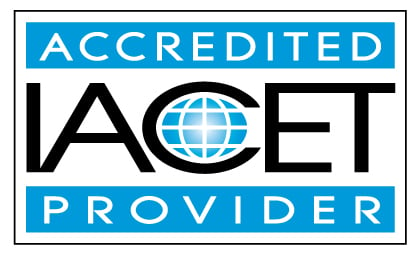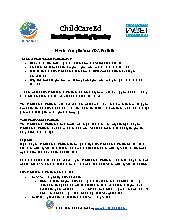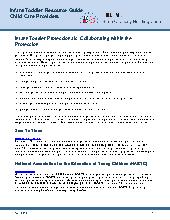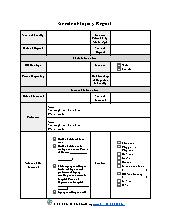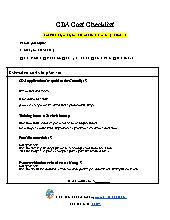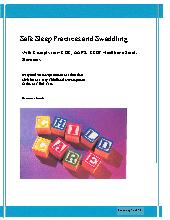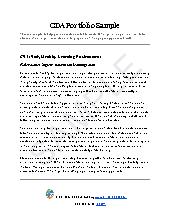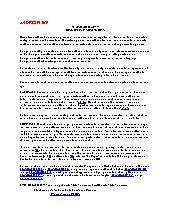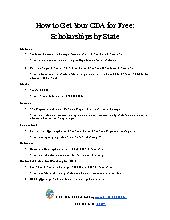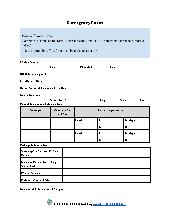CDA Infant/Toddler Renewal
After receiving their CDA credential, child care professionals must complete coursework to renew every three years before their credentials expires. The purpose of renewal is to reaffirm the provider’s knowledge and competence for teaching infants and toddlers. This child care course provides all the needed hours in all eight of the CDA's competency standards.
By the end of this training, the learner will be able to:
- Identify the causes and locations of child injuries at childcare settings.
- Identify recommended medical and immunization schedules for children birth through age three
- Identify strategies for effective communication with families.
- Identify types of abuse in infants and toddlers, how to report, and who are mandated reporters.
- Identify strategies to promote cultural diversity and acceptance in the child care environment.
- Recognize the importance of consistency, continuity, and responsiveness in supporting pro-social behaviors in children.
- Demonstrate an understanding of approaching parents as equal partners in learning.
- Give examples of strategies to help children resolve conflict amongst themselves.
- Identify the signs of traumatic brain injury in infants and young children.
- Demonstrate understanding of the harmful effects of excessive sun exposure in infants and young children.
- Recognizing and preventing shaken baby syndrome
- Describe a classroom management plan that promotes positive reinforcement, clear expectations, and consistent implementation.
- Recognize strategies for effective conferences with families.
- List safety risks for infants and toddlers and strategies to diminish these risks.
- List recommended feeding schedules and identify strategies for introducing new food for children birth through age three.
- List benefits to a multicultural and inclusionary environment.
- Describe the difference between unintentional injuries and nonfatal injuries children can experience.
- Describe the impact of culture on infant and toddler development
- Describe the importance of learning centers in the early childhood education environment.
- Describe the primary learning centers and their components.
- Describe the steps teachers should take to identifying challenging behaviors.
- Describe the various ways teachers can address challenging behaviors in the classroom.
- Identify ways to reflect on one's own personal perspectives with courage and/or humility
- Identify ways to examine child behavior to prepare for guidance.
- Identify theorists of guidance and discipline
- Give examples of strategies teachers can use to communicate with parents regarding challenging behaviors.
- Identify Jean Piaget's stages of cognitive development.
- Identify theory and theorist in relation to child development.
- Demonstrate an understanding of typical and atypical development from birth to age 2..
- Identify the stages and milestones of development from birth to age 2.
- Identify resources for referral and specialized services.
- List resources and the referral process for infants and toddlers with a suspected/diagnosed disability.
- Define mental health and its Indicators in infants and young children.
- Demonstrate an understanding of potential violations of confidentiality and take steps to reduce the risk of occurrence.
- Demonstrate Understanding of Meal Planning for young children.
- Demonstrate understanding of appropriate interaction with infants and toddlers.
- Demonstrate an understanding of appropriate supervision for all children’s activities.
- Identify appropriate practice for the identification, prevention, and treatment of communicable diseases in childcare.
- Give examples of strategies in responding to typical child care situations.
- Demonstrate how to develop policies and procedures that promote good hygiene
- Demonstrate how theory is reflective in the child care environment.
- Identify strategies to listen while withholding judgement about the new or unfamiliar
- Identify the components of the MY Plate.
- Demonstrate understanding of an IFSP and removing barriers
- Demonstrate an understanding of how to implement an Individual Family Support Plan.
- Demonstrate understanding of developing strategies for involving parents in the child care setting.
- Give examples of strategies caregivers can use to ensure safe sleeping habits and the prevention of SIDS/SUIDS in infants.
- List the most common reasons why infants and toddlers bite.
- Give examples of strategies to prevent traumatic brain injuries in infants and young children.
- Recognize the needs of individualized learning for infants and toddlers.
- Demonstrate understanding of the importance of parent/caregiver relationship
- Identify strategies for the child care provider that will promote successful child development.
- Identify different learning styles of young children
- Identify adaptations to materials and equipment for children with diagnosed special needs or delay
- Demonstrate an understanding of how to be open to new perspectives and diverse others.
- Describe ways child care professionals can display leadership with families and the community.
- Identify different types of play.
- Define the term multiculturalism and how it relates to the child's environment.
- Demonstrate an understanding of how available materials and equipment guide activity development
- Identify strategies for integrating culture and diversity into an infant and toddler program
- Demonstrate an understanding of diverse perspectives, and navigate the ambiguity and complexity that comes with that.
- List the steps to complete a report on abuse and neglect.
- Identify the importance of professional development for child care professionals and strategies to make meaningful choices.
- Describe the meaning of positive discipline in the classroom.
- Identify causes of obesity in children.
- Demonstrate an understanding of proper food storage and preparation.
- Identify strategies to assist children with food allergies/feeding concerns.
- Recognize the importance of problem solving and conflict resolution strategies with community members and families
- Identify the requirements of an appropriate environment that will promote free exploration and manipulation.
- Demonstrate understanding of effective listening skills in childcare.
- Criteria to earn CEUs:
- Certificates are awarded when the following criteria have been met by the learner:
- Class has been paid in full
- All material has been reviewed
- All review questions and final test have been completed with a passing score of 80% or higher.
- Learning Assessment Method:
- Learners will be assessed through questions after every section is completed. Learners will not be
allowed to proceed to the next section of the training until all questions have been answered correctly.
Learners will be presented with a final test composed of true/false and multiple choice questions.
Upon successful completion of the training, learners will receive their certificate by email.
- Learning Methodology:
- Online material will be presented in the form of slides,
accompanied with speech. Videos will be used to demonstrate ideas and concepts. Charts and tables
will be used for illustration.
- Logistics/Required Technology:
- A stable internet connection is required for the completion of this course. Users are highly encouraged to take their online course on Google Chrome on either a laptop or desktop computer. Speakers and/or headphones are also required to hear speech.
- Payment Policy:
- Payments need to be made in full. No refunds will be issued after starting the class.
- Proprietary or conflict of interest disclosure:
- Unless otherwise stated in the course description none of H & H subject matter experts and editor has any conflict or proprietary interests related to the material they prepared in this course.
- Support Services:
- Please visit our contact us page
You are purchasing a session of an online training that includes online assessments. Your certificate will be emailed to you once you pass the final exam with a passing grade of 80%.
Your certificate will bear the name you provided to us when you signed up. For support and questions regarding the material presented in this class please contact us at info@childcareed.com. Please consult our frequently asked questions page for other questions or feel free to contact us.
No prerequisites are required for the completion of this course.
Hours breakdown
8 CD/7 CUR/8 HSN/7 SN/8 PRO/7 COMTopics / Categories
Group AdminInfant/ Toddler Educators
Not Applicable
Basic
Health, safety and nutrition
Curriculum and Environment
Professionalism
Child development
Observation and Assessment
Special Needs
Latest Jobs
- UNITED STATES OF AMERICA - Maryland
- UNITED STATES OF AMERICA - Arkansas
- UNITED STATES OF AMERICA - Connecticut
- UNITED STATES OF AMERICA - Delaware
- UNITED STATES OF AMERICA - District of Columbia
- UNITED STATES OF AMERICA - Michigan
- UNITED STATES OF AMERICA - Nevada
- UNITED STATES OF AMERICA - New York
- UNITED STATES OF AMERICA - Oklahoma
- Nurturing Tiny Minds: The Path to a CDA Infant/Toddler Credential
- The Importance of Infant and Toddler CDA Certification in Early Childhood Education
- Infant-Toddler CDA Certification: Your Key to Specializing in Early Childhood Care

